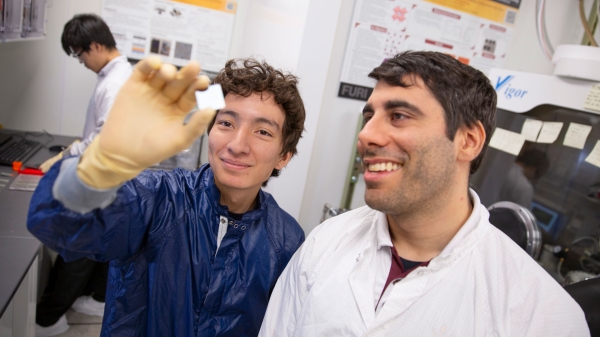Defying materials research limitations

Seth Ariel Tongay, a professor of materials science and engineering in the School for Engineering of Matter, Transport and Energy, part of the Ira A. Fulton Schools of Engineering at Arizona State University, in his lab. He has been named an American Physical Society Fellow and appointed as a Navrotsky Professor of Materials Research. Photo by Erika Gronek/ASU
There are few things as pivotal to our lives as materials, and far fewer recognitions that feel as good to a materials scientist as receiving the American Physical Society Fellowship, or APS Fellowship. In fact, fewer than half of 1% of APS members are elected to the status of fellow each year.
In recognition of his outstanding work on the development and understanding of two-dimensional materials, Seth Ariel Tongay has been elected as an APS Fellow. Tongay is a professor of materials science and engineering and research director in the School for Engineering of Matter, Transport and Energy, part of the Ira A. Fulton Schools of Engineering at Arizona State University.
While he has received many awards throughout his career, including his recent appointment as the Navrotsky Professor of Materials Research, for him, getting the APS Fellowship is a hall-of-fame type of moment.
“It is a massive honor for me,” Tongay says.
Working with industry to make research work
Since joining ASU approximately 10 years ago, Tongay has been studying ultra-thin, two-dimensional materials, and, most importantly, developing precise manufacturing techniques that enable industry to easily integrate them into their workflows.
“Two-dimensional materials behave differently compared to any other materials that we know,” he says. “In materials science, the dimensionality of a material changes its properties even though it is made out of the same elements and atoms.”
If every material can exist in various dimensions, what makes two-dimensional materials such a big deal?
Imagine using LEGO bricks to build a spooky house — except this time, you’re starting with a complete and solid house that you have to destroy brick by brick to rebuild a spookier structure. As you approach the bottom of the LEGO house, you realize that the building blocks get weaker and more impractical. Technology companies face the same issues today.
Engineers always try to produce smaller, more powerful devices by using thinner and more stable materials. One of the most widely used materials to make semiconductor devices, for example, is silicon, and as a three-dimensional material, it gets more unstable the smaller it is sliced. Just as you would have to look for more reliable bricks to build your spooky LEGO house, technology companies are searching for more stable alternatives to current semiconductor materials.
Two-dimensional materials, such as graphene, are some of the most promising options due to their incredible stability and conductive properties at an extremely small scale; however, the quality that makes these materials special is the same thing that hinders industry from using them to make products.
“The thickness of two-dimensional materials can be as small as 0.7 nanometers or lower,” Tongay says. “To put (that) in perspective, an average strand of human hair is five microns, which is about 10,000 times thicker than a 0.7 nanometer material.”
After many years of research, Tongay understood that, while stable and powerful, engineers wouldn’t be able to use this class of materials at that scale. So he dared to redirect his research and set out to develop innovative techniques to manufacture them at a scale usable for various industry applications.
He is currently developing materials known as 2D Janus, named after the ancient Roman god of transitions and dualities. Just as Janus had two faces, one looking to the future and another looking toward the past, 2D Janus materials have two sides made with completely different materials.
An example of such a material is molybdenum, which contains sulfur on one side and selenium on another. The material exists in nature as molybdenum disulfide. Using novel materials manufacturing techniques, Tongay swaps one layer of sulfur with selenium. He says that breaking that symmetry leads to material properties that cannot be found anywhere else.
“I found that this material structure produces an infinite, self-driven electric field,” Tongay says. “When made appropriately, two-dimensional materials like this can be great metals, superconductors and magnetic materials.”
As the race to artificial super-intelligence continues, there’s never been a more immense need to find efficient semiconductor materials. Tongay and his team are collaborating with industry partners to tailor various two-dimensional materials that suit their needs.
He says he is passionate about reducing barriers between industry and academia so that each community can benefit from the other.
“As researchers, we need to understand the needs of industry to be able to help them make better technologies and solve some of the most pressing issues,” Tongay says.
Tongay says he is excited to continue raising the bar and contributing to the materials research community.
“To the members of APS who trusted me with this honor, I cannot thank you enough,” he says. “I aim to continue developing new material systems with remarkable properties and performance that current materials cannot achieve, significantly advancing the field of materials research.”
More Science and technology

ASU student researchers get early, hands-on experience in engineering research
Using computer science to aid endangered species reintroduction, enhance software engineering education and improve semiconductor material performance are just some of the ways Arizona State…

ASU professor honored with prestigious award for being a cybersecurity trailblazer
At first, he thought it was a drill.On Sept. 11, 2001, Gail-Joon Ahn sat in a conference room in Fort Meade, Maryland. The cybersecurity researcher was part of a group that had been invited…

Training stellar students to secure semiconductors
In the wetlands of King’s Bay, Georgia, the sail of a nuclear-powered Trident II Submarine laden with sophisticated computer equipment juts out of the marshy waters. In a medical center, a cardiac…